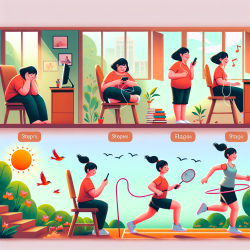Introduction
In the quest to improve outcomes for children and young adults, understanding the intricate web of factors influencing their health behaviors is paramount. A recent study published in the International Journal of Environmental Research and Public Health sheds light on the complex interplay between weight-related self-stigma, smartphone addiction, and physical activity levels among female university students. This blog aims to distill the findings of this study and explore how practitioners can leverage these insights to enhance their practice and outcomes for their clients.
The Study: A Closer Look
The study titled Effects of Weight-Related Self-Stigma and Smartphone Addiction on Female University Students’ Physical Activity Levels delves into how weight-related self-stigma (WRSS) and smartphone addiction (SPA) affect physical activity (PA) among female university students in Taiwan. Using a cross-sectional design, the researchers collected data from 391 participants, examining the relationships between these variables.
Key Findings
- Weight-Related Self-Stigma: WRSS was found to negatively impact PA levels. Students with higher self-stigma were less likely to engage in physical activities.
- Smartphone Addiction: SPA was identified as a significant moderator in the relationship between WRSS and PA. High levels of smartphone addiction exacerbated the negative effects of self-stigma on physical activity.
- Combined Impact: The combination of high WRSS and SPA was associated with the lowest levels of physical activity, suggesting a compounded effect on students' health behaviors.
Implications for Practitioners
For practitioners working with young adults, particularly female university students, these findings offer a data-driven foundation for designing interventions. Here are some actionable insights:
- Address Self-Stigma: Develop programs that help students build a positive self-image and reduce internalized weight stigma. This could involve counseling sessions, peer support groups, or workshops focused on body positivity.
- Monitor Smartphone Use: Encourage students to be mindful of their smartphone use. Implement strategies such as digital detox programs or workshops on healthy technology habits to mitigate the impact of SPA.
- Promote Physical Activity: Create engaging and accessible physical activity programs tailored to the interests and schedules of female university students. Consider incorporating technology, such as fitness apps, to motivate and track progress.
Encouraging Further Research
While this study provides valuable insights, it also highlights the need for further research. Practitioners are encouraged to explore additional factors that may influence physical activity levels, such as cultural differences, access to resources, and individual psychological traits. Collaborative research efforts can lead to more comprehensive and effective intervention strategies.
Conclusion
Understanding the factors that influence physical activity in young adults is crucial for promoting healthier lifestyles. By addressing weight-related self-stigma and smartphone addiction, practitioners can empower female university students to engage in more physical activity, ultimately improving their overall well-being. As we continue to uncover the complexities of these relationships, we can better support our clients in achieving their health goals.
To read the original research paper, please follow this link: Effects of Weight-Related Self-Stigma and Smartphone Addiction on Female University Students’ Physical Activity Levels.










